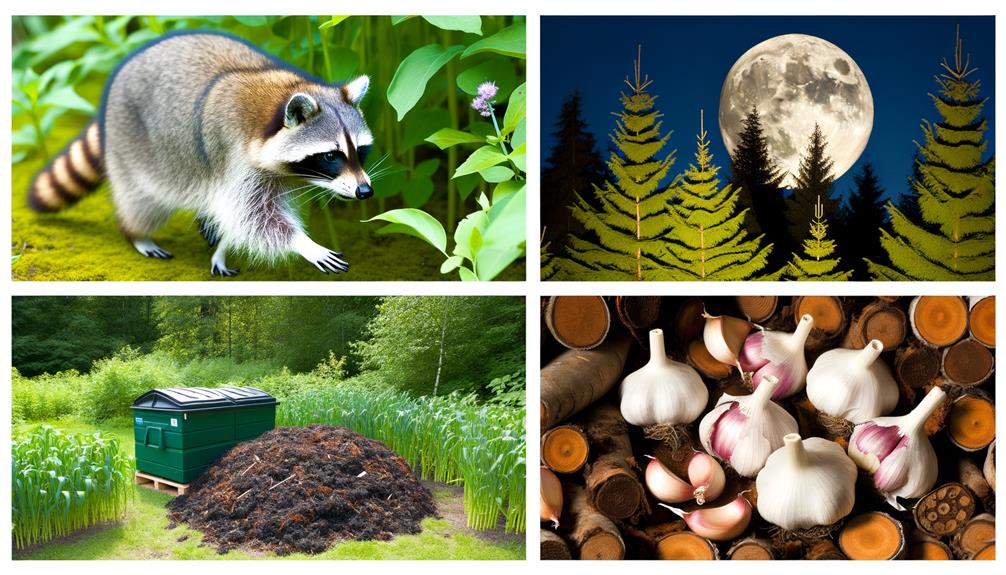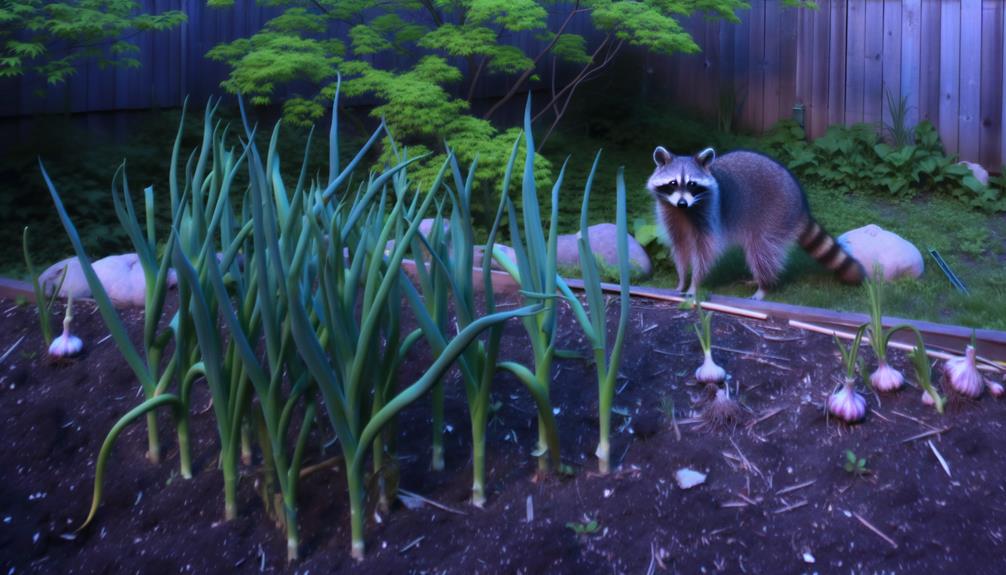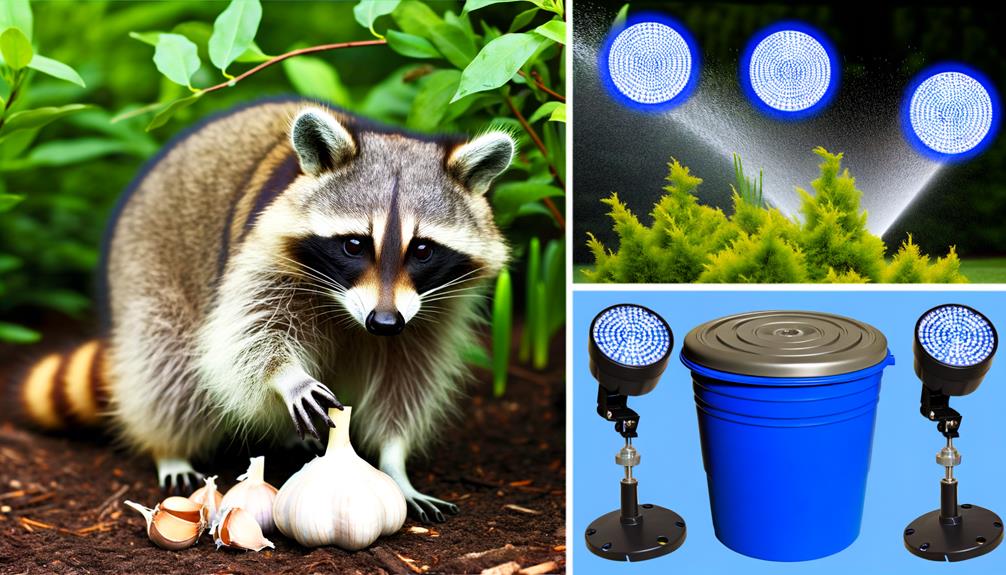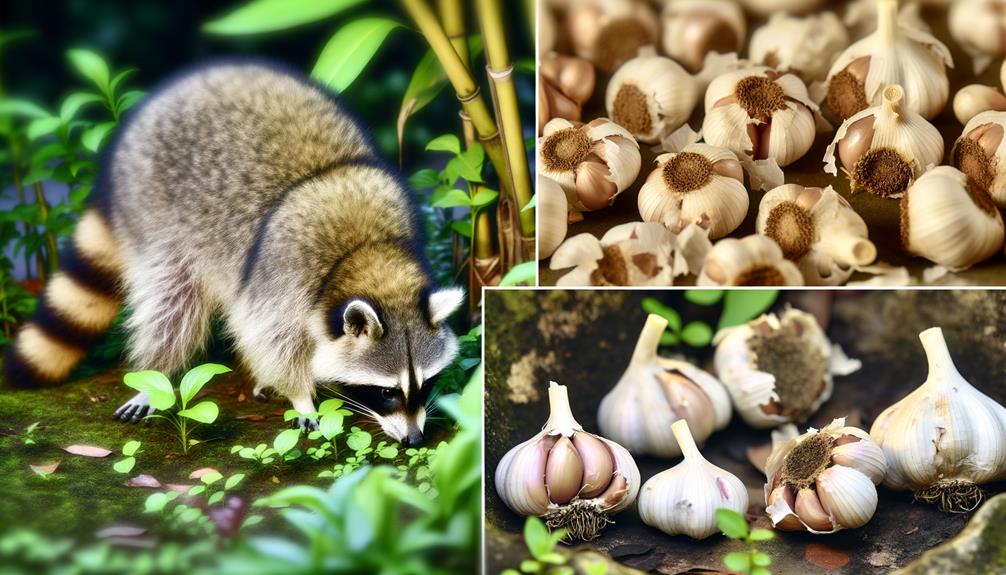Do Raccoons Like the Smell of Garlic?
Raccoons possess a highly developed olfactory system, with numerous olfactory receptors that make them sensitive to various scents. Research indicates that raccoons generally find the smell of garlic unappealing.
This aversion is attributed to sulfur-containing compounds like allicin and methyl mercaptan, which produce a potent aroma. Studies show raccoons exhibit avoidance behavior, hesitant approach, and rarely consume garlic.
Consequently, garlic can serve as an effective natural deterrent when used around trash bins and garden beds. For a thorough raccoon management strategy, integrating garlic with other deterrents may enhance effectiveness and reduce raccoon disturbances further.

Key Takeaways
- Raccoons exhibit increased wariness and avoidance behavior when exposed to garlic's potent aroma.
- Garlic's sulfur-containing compounds make it a strong deterrent for raccoons.
- Raccoons rarely consume garlic, showing minimal direct interaction with it.
- Garlic can effectively mitigate raccoon disturbances when placed around trash bins and garden beds.
- Homeowners report mixed experiences but often find garlic a successful, natural deterrent for raccoons.
Understanding Raccoon Behavior

Raccoon behavior is characterized by their nocturnal activity patterns, omnivorous diet, and highly adaptable nature. These animals exhibit peak activity during nighttime, leveraging their acute sense of vision and dexterous forepaws to forage and manipulate objects.
Their diet is highly varied, encompassing fruits, insects, small vertebrates, and human refuse, reflecting their opportunistic feeding strategies. Adaptability allows raccoons to thrive in diverse environments, from rural woodlands to urban areas.
Studies indicate that their cognitive abilities enable problem-solving and memory retention, facilitating navigation of complex habitats. This behavioral plasticity is a key driver of their success, enabling raccoons to exploit a wide range of resources and survive in fluctuating ecological conditions.
Understanding these behaviors provides insight into their ecological roles and interactions.
The Sense of Smell in Raccoons
Possessing a highly developed olfactory system, raccoons rely extensively on their sense of smell to locate food, identify potential threats, and communicate with conspecifics.
This heightened olfaction is facilitated by a large olfactory bulb and numerous olfactory receptors, which allow raccoons to detect a wide range of scent molecules.
Studies indicate that raccoons can differentiate between various food sources, even those buried underground, showcasing their keen scent-tracking abilities.
Additionally, olfactory cues play a critical role in social interactions, such as marking territory and recognizing kin.
This reliance on olfaction underscores the importance of odor in the behavioral ecology of raccoons, making understanding their scent preferences essential for both wildlife management and human-raccoon conflict mitigation.
Common Raccoon Deterrents

Effective raccoon deterrents can be categorized into natural repellent options and commercial deterrent products. Studies have shown that certain natural substances, such as garlic and ammonia, can greatly reduce raccoon activity.
In addition, a variety of commercially available products, including ultrasonic devices and chemical sprays, are designed to deter raccoons based on sensory irritation and behavioral modification.
Natural Repellent Options
Utilizing natural repellent options, such as garlic and other strong-smelling substances, can serve as effective deterrents against raccoon infestations. Studies indicate that raccoons possess a highly sensitive olfactory system, making them averse to certain odors. Empirical evidence supports the efficacy of various natural repellents in mitigating raccoon activity. Significantly, these options are both environmentally friendly and cost-effective.
Key natural deterrents include:
- Garlic: Its pungent smell can repel raccoons.
- Ammonia: Mimics the scent of predator urine, causing avoidance.
- Peppermint oil: Strong aromatic properties deter raccoons.
- Hot peppers: Capsaicin, the active component, irritates raccoon nasal passages.
- Vinegar: Strong acetic acid smell acts as a deterrent.
Incorporating these natural repellents can notably reduce raccoon interactions without relying on chemical interventions.
Commercial Deterrent Products
Commercial deterrent products, such as ultrasonic devices and motion-activated sprinklers, have gained popularity for their scientifically validated effectiveness in deterring raccoons. Ultrasonic devices emit high-frequency sounds that are inaudible to humans but distressing to raccoons, thereby discouraging their presence. Studies have shown that these devices can reduce raccoon activity by up to 80%.
Motion-activated sprinklers utilize sudden bursts of water to startle and repel raccoons, with evidence indicating a 70-90% reduction in raccoon intrusions. Additionally, chemical repellents containing substances like capsaicin have demonstrated efficacy in deterring raccoons from treated areas.
These commercial products offer a data-driven, reliable approach to raccoon management, presenting viable alternatives to traditional, less effective methods.
Garlic's Potent Aroma
Garlic's potent aroma is primarily due to the presence of sulfur-containing compounds such as allicin. These compounds are released when garlic cloves are crushed, chopped, or chewed.
The intensity of garlic's smell can be attributed to several key factors:
- Allicin: Formed enzymatically when garlic is cut, contributing to its pungency.
- Diallyl Disulfide: Adds to the characteristic odor and has antimicrobial properties.
- Methyl Mercaptan: A volatile sulfur compound that is highly odorous.
- S-allyl cysteine: Water-soluble, contributing to the long-lasting aroma.
- Thiosulfinates: Break down into various sulfur compounds, enhancing the smell.
These components create garlic's distinctive and strong scent, which is detectable even in small quantities.
Understanding these properties is essential for exploring their effects on different species.
Raccoons' Reaction to Garlic

Given garlic's potent sulfur-containing compounds, it is pertinent to investigate how raccoons react to its distinctive smell. Observational data indicate that raccoons exhibit various responses when exposed to garlic. The following table summarizes these reactions:
| Observation | Raccoon Behavior |
|---|---|
| Initial Approach | Hesitant, with frequent sniffing |
| Proximity | Increased wariness, occasional retreat |
| Contact | Minimal direct interaction; avoidance |
| Consumption | Rare, typically avoided |
Raccoons appear to be deterred by the pungent aroma of garlic, showing reluctance to engage closely with garlic-laden areas. Their initial curiosity is often overshadowed by a tendency to avoid prolonged exposure, suggesting an aversive reaction. This behavior underscores the potential utility of garlic in managing raccoon activity in specific environments.
Scientific Studies on Garlic as a Deterrent
Numerous scientific studies have investigated the efficacy of garlic as a deterrent for raccoons, focusing on its biochemical properties and behavioral impacts. Research has highlighted several key findings:
- Allicin: The compound allicin, released when garlic is crushed, has been shown to have repellent properties for many animals.
- Behavioral Avoidance: Experimental setups indicated raccoons tend to avoid areas treated with garlic extracts.
- Field Trials: Field studies demonstrated a significant reduction in raccoon activity in garlic-treated zones.
- Olfactory Sensitivity: Raccoons possess a highly developed sense of smell, making them particularly susceptible to pungent odors like garlic.
- Comparative Analysis: Studies comparing garlic to other natural deterrents have found garlic to be highly effective.
These findings collectively suggest garlic's potential as a raccoon deterrent.
Practical Uses of Garlic for Deterring Raccoons

In practical applications, utilizing garlic as a raccoon deterrent involves methods such as creating garlic-infused sprays, strategically placing garlic cloves, and incorporating garlic powder into garden soil. These methods are designed to exploit raccoons' aversion to the strong smell of garlic, thereby reducing their presence in targeted areas. Empirical data supports these methods as effective deterrents when consistently applied. The table below summarizes these methods:
| Method | Application Area | Frequency of Use |
|---|---|---|
| Garlic-infused Spray | Perimeter of gardens | Weekly |
| Garlic Cloves | Near trash bins, garden beds | Bi-weekly |
| Garlic Powder | Mixed into soil | Monthly |
| Garlic Oil | Sprayed on plants | Bi-weekly |
| Garlic Bulbs | Planted around garden | Seasonal |
These strategies, when implemented correctly, can effectively mitigate raccoon disturbances.
Other Natural Deterrents for Raccoons
In addition to garlic, several other natural deterrents have demonstrated efficacy in repelling raccoons.
Research indicates that predator urine can create an environment that raccoons find threatening, while certain strong-scented plants, such as peppermint and lavender, can disrupt their olfactory senses.
Moreover, ultrasonic repellent devices have been shown to emit frequencies that are unpleasant to raccoons, thereby reducing their presence in targeted areas.
Predator Urine Effectiveness
Predator urine, particularly from coyotes and foxes, has shown varying levels of effectiveness as a natural deterrent for raccoons in controlled studies. Research indicates that the application of predator urine can reduce raccoon activity due to the perceived threat of predators. However, its effectiveness can vary based on several factors:
- Concentration: Higher concentrations tend to be more effective.
- Application Frequency: Regular reapplication is necessary to maintain the deterrent effect.
- Environmental Conditions: Rain and other weather conditions can dilute or wash away the urine, reducing its efficacy.
- Raccoon Acclimatization: Over time, raccoons may become accustomed to the scent, diminishing its deterring power.
- Alternative Food Sources: The presence of easily accessible food can override the deterrent effect of predator urine.
These factors highlight the complexity in using predator urine as a reliable raccoon deterrent.
2. Strong Scent Plants
How effective are strong scent plants in deterring raccoons from gardens and urban areas?
Studies indicate that raccoons possess a highly developed olfactory system, making them sensitive to potent odors. Plants such as garlic, marigolds, and lavender emit strong scents that can overwhelm raccoons' sense of smell, acting as natural deterrents.
Research shows that these plants can create an unfavorable environment for raccoons, reducing visits to areas where they are cultivated. However, efficacy varies depending on the density of planting and the persistence of the scent.
While not foolproof, integrating strong scent plants into gardens can be a sustainable, eco-friendly strategy to mitigate raccoon activity, complementing other deterrent measures.
3. Ultrasonic Repellent Devices
Ultrasonic repellent devices emit high-pitched sounds that are inaudible to humans but can effectively discourage raccoons by causing auditory discomfort. These devices leverage the heightened auditory sensitivity of raccoons, making environments less welcoming for them.
Studies indicate varying effectiveness, often dependent on device placement and environmental factors. Key features to take into account include:
- Frequency range: Ideal frequencies range between 20-65 kHz.
- Coverage area: Devices with wider coverage areas ensure more comprehensive protection.
- Motion sensors: These improve efficiency by activating only when movement is detected.
- Power source: Options include battery-operated, solar-powered, or plug-in devices.
- Durability: Weather-resistant models offer extended functionality outdoors.
Ultrasonic devices represent a non-intrusive, compassionate approach to raccoon deterrence, complementing other natural methods like plants with strong scents.
Combining Garlic With Other Methods

Integrating garlic with other deterrent methods can enhance the overall effectiveness of raccoon control strategies. Research indicates that combining olfactory repellents such as garlic with visual and auditory deterrents, like flashing lights and ultrasonic devices, creates a multi-sensory environment that raccoons find unwelcoming.
Studies have shown that while garlic alone may reduce raccoon activity by approximately 30%, the addition of motion-activated lights can increase deterrence levels up to 70%. Moreover, the use of physical barriers, such as reinforced fencing, in conjunction with chemical repellents, provides a thorough approach.
Data-driven analyses suggest that a multi-faceted strategy not only leverages the strengths of each individual method but also mitigates the limitations, thereby achieving a more robust raccoon management solution.
Homeowner Experiences With Garlic
Homeowners have reported mixed experiences when using garlic as a raccoon repellent. Some individuals have found garlic to be an effective deterrent, while others have observed negligible impact on raccoon activity.
Additionally, alternative repellent methods have been suggested by those for whom garlic proved ineffective.
Successful Repellent Stories
Numerous documented cases highlight how homeowners have effectively deterred raccoons by utilizing garlic as a natural repellent. Empirical evidence from various sources demonstrates that garlic can serve as a potent deterrent when used correctly.
These successful repellent stories are characterized by several common practices:
- Crushed garlic cloves: Placed around the perimeter of gardens or entry points.
- Garlic-infused water: Sprayed on plants and potential raccoon pathways.
- Garlic powder: Sprinkled in attics and basements.
- Garlic oil: Mixed with other essential oils and applied to trash cans.
- Garlic-based commercial repellents: Utilized with consistent application.
These methods reflect a trend towards embracing natural, non-toxic solutions for raccoon control, supporting their effectiveness through repeated homeowner experiences.
Ineffective Deterrent Instances
Despite widespread anecdotal support, there are documented cases where garlic-based deterrents have failed to prevent raccoon incursions. Various homeowners have reported persistent raccoon activity despite the application of garlic in different forms. The data in Table 1 summarizes instances of inefficacy, highlighting the variability in outcomes.
| Homeowner ID | Garlic Form Used | Result |
|---|---|---|
| H1 | Garlic spray | Continued incursions |
| H2 | Crushed garlic | Minimal deterrence |
| H3 | Garlic powder | No observable effect |
| H4 | Garlic cloves | Raccoons undeterred |
These findings suggest that while garlic may work in some scenarios, it is not a foolproof solution. The reasons behind these inconsistent results warrant further scientific investigation to determine the underlying factors influencing raccoon behavior.
Alternative Repellent Suggestions
Given the inconsistent efficacy of garlic as a deterrent, homeowners have explored various alternative repellents to mitigate raccoon activity. Empirical data from homeowner reports suggest several methods have shown varying degrees of success.
These alternatives include:
- Ammonia-soaked rags: The strong odor of ammonia is often cited as an effective deterrent.
- Motion-activated sprinklers: These devices startle raccoons with sudden bursts of water.
- Capsaicin-based sprays: Derived from hot peppers, these sprays create a pungent barrier.
- Ultrasonic devices: Emit high-frequency sounds that are unpleasant to raccoons.
- Predator urine: Specifically coyote or fox urine, which can create the illusion of a nearby predator.
Evaluating these methods' effectiveness can offer valuable insights for homeowners seeking raccoon deterrents.
Effectiveness of Garlic Over Time

Studies indicate that the initial repellent effect of garlic on raccoons diminishes noticeably after 48 hours. This decline in effectiveness is attributed to the volatile compounds in garlic that dissipate over time. Empirical evidence suggests that raccoons become increasingly tolerant as the odor weakens, undermining garlic's long-term utility as a repellent.
| Observation Time | Effectiveness |
|---|---|
| 0-24 Hours | High |
| 24-48 Hours | Moderate |
| After 48 Hours | Low |
The data underscores the necessity for frequent reapplication to maintain efficacy. For those seeking sustainable pest control, reliance on garlic alone may prove insufficient. Complementary strategies, possibly integrating other deterrents, should be considered to achieve best results in raccoon management.
Conclusion
Despite garlic's widespread acclaim as a potent deterrent, raccoons exhibit an ironic indifference to its pungent aroma. Data suggests that while garlic may temporarily dissuade these nocturnal scavengers, its long-term effectiveness is debatable.
Homeowners employing garlic as a standalone solution often find themselves returning to more reliable methods. In the grand scheme of raccoon deterrence, garlic's famed potency appears to be more myth than reality, highlighting the necessity for integrated pest management strategies.






